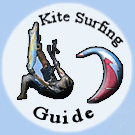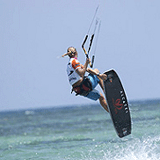Control Devices
The way a kitesurfer is able to control the kite is by using a control device. Thus , kitesurfers can ride their kites so that they manage to fly a kite within the wind window. Basically, a wind window is the area you can see with your eyes, meaning 85 degrees to the left, 85 degrees to the right, 85 degrees upward, while facing straight down wind. Kitesurfers usually have a 2 line control bar for a 2-line kite, a 4 line control bar for a 4 line inflatable, and a pair of handles or a 4 line control bar for a 4-line foil.
Inflatable Control Devices
A kitesurfer can pull the left end of the bar to turn the kite to the left and pull the right end of the bar to the kite to the right, all this when using a 2-line inflatable with a 2-line control bar. The kite will follow its current flight path and then it will fly to the edge of the wind window, should the bar be in a neutral position.
When speaking of the 4 line inflatable, note that it has a 4 line control bar. The front lines are tied to a center leader line , while the two back lines are tied to the leader lines at the ends of the bar. In order for surfers to modify the angle of attack of the kite, the kites have adjustable strap and "chicken loop" set up on the center line, that they can make shorter. By changing the angle of attack of the kite, kitesurfers modify the power of the kite.
In case you own a a 4 line inflatable and you are not too happy about the of the lines after a spin, my advice is to rig a spin leash. Thus you will be able to untwist the lines more easily after a spin. Should you use this system, be careful to connect the safety leash portion only when launching or landing. You must hook-in or connect the depowering portion only in open water.
Inflatable Depowering System
Reducing the AOA by shortening the front leader line will depower a 4 line inflatable. On the other hand, by increasing the AOA , as a result of lengthening the front leader line, will empower a 4 line inflatable. You can also use a chicken loop or a trim strap to do all this shortening and lengthening of the front leader line. Many kitesurfers tie the front leader line to their harness, and then , by using a quick release mechanism, they release it.
Foil Control Devices
By pulling on the left handle, you can turn a foil to the left and by pulling on the right handle you will turn the kite to the right, all this when using a pair of 4 line handles. This is quite the same as on a 2 line kite. You can make the kite faster very simply: just pulling on a brake line. Remember that the brake lines are the 2 back lines and the main lines are the 2 front lines. Pull on the left brake line to turn the kite to the left or pull on the right brake line to turn the kite to the right. An interesting thing happens on 4 line kites: if you pull on one of the brake line while shortly after pulling on the other main line, you will spin on the same spot. Should the handles be neutral, the kite will keep on flying on its path and fly to the edge of the wind window. If the bridle of some kites is in a certain position, the kites will hover on the same spot and not move forwards. In this case, you must slightly pull on both of the main lines to move it . If you may wish to slow down a kite, pull slightly on both of the brake lines ; if you wish to stop it just pull harder on both of the brakes lines and if you want to move it backward, pull harder on the two brake lines.
Control your foil through a 4 line bar, at its center being tied the front lines, at about 20 cm from each other, and at its both ends being the brake lines.
If you have a line that connects the front bridle to the trailing bridle , which is called a power steering bridle, you can try to connect your front lines to both ends of the bar and a center line to the trailing bridle, thus rigging a 3 line set up, similar to that of the Concept Air New Wave.
The foils nowadays having AOA control use the bar setup of the 4 line inflatables.
Foil Depowering Systems
Foils have numerous depowering systems:
- Depowering by changing camber: this is a system by which a kitesurfer can shorten or lengthen the trailing line to increase or to decrease the trailing camber of the kite, thus increasing or decreasing its power. Concept Air New Wave used this kind of system.
- Depowering by neutralize a section of foil: by using this system, the surfers are able to pull on a line and flatten the middle section of the kite, so that he can depower his kite. Rage and Windtools Mosquito were the producers to use this system.
- Depowering by changing AOA: this type of system allows the rider to change the AOA of the foil, and is wery much alike the systems on the inflatables. Arc, Boom Vector, ConceptAir and Flysurfer have marketed this system
- Depowering by changing foil/sled shape: by using this kind of system you can make a flat foil turn into a sled and the other way around.
Reel Bars
2 line inflatables can have a 2 line reel bar, thus offering the chance to easily launch the kite in a crowded area. If you use a 2 line reel bar you can sail with different line lengths without having to change the lines.
Unfortunately, reel bars are not widely used by kitesurfers nowadays.
Safety Systems
No matter which type if control device you are using on your own kite, it must absolutely have a reliable dead-man safety release system. This is mainly essential on inflatable kite. Even if you should become unconscious and not holding the bar anymore, the dead-man safety release system must disable the kite completely. The system must give you the chance to retrieve the kite and the control device, thus allowing you not to loose the kite in such a situation. The dead-man release system on the control device of your kite must always be tested before use , in a light wind area. My advice is for you to test it in shallow water, as when activating the safety release system on land, many kites can crash.
YOU MUST NEVER USE A CONTROL DEVICE THAT DOES NOT HAVE A DEAD-MAN SAFETY RELEASE SYSTEM INCORPORATED.
When hooking in to your harness, some dead-man safety release systems do not function anymore. Only few of them give a kiter the opportunity to "consciously" pull on some quick release mechanism to disable the kite. The thing to be remembered is that you must always be cautious and unhook in suspicious situations, for example when hard objects come close to you or when on land and next to the shore.


